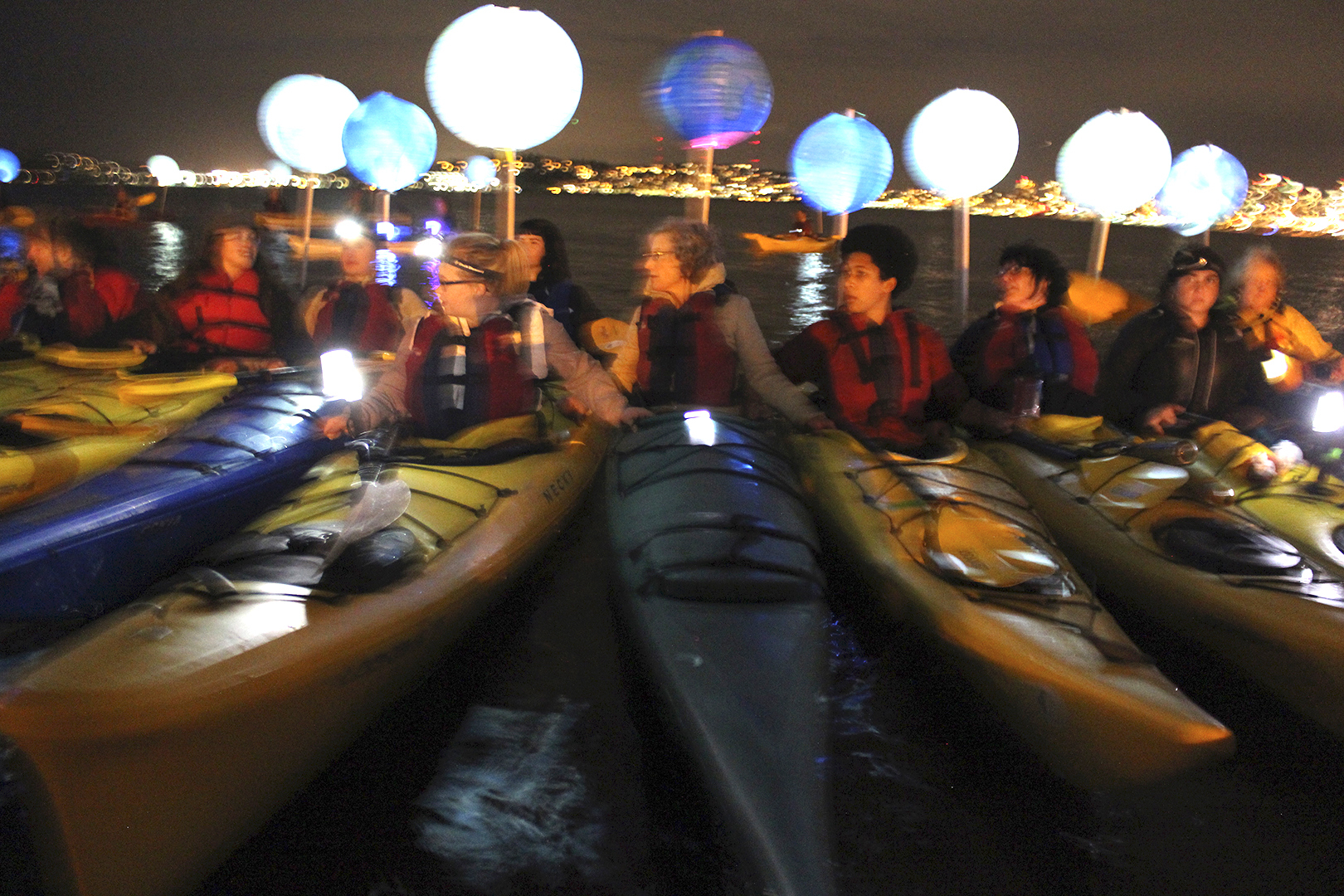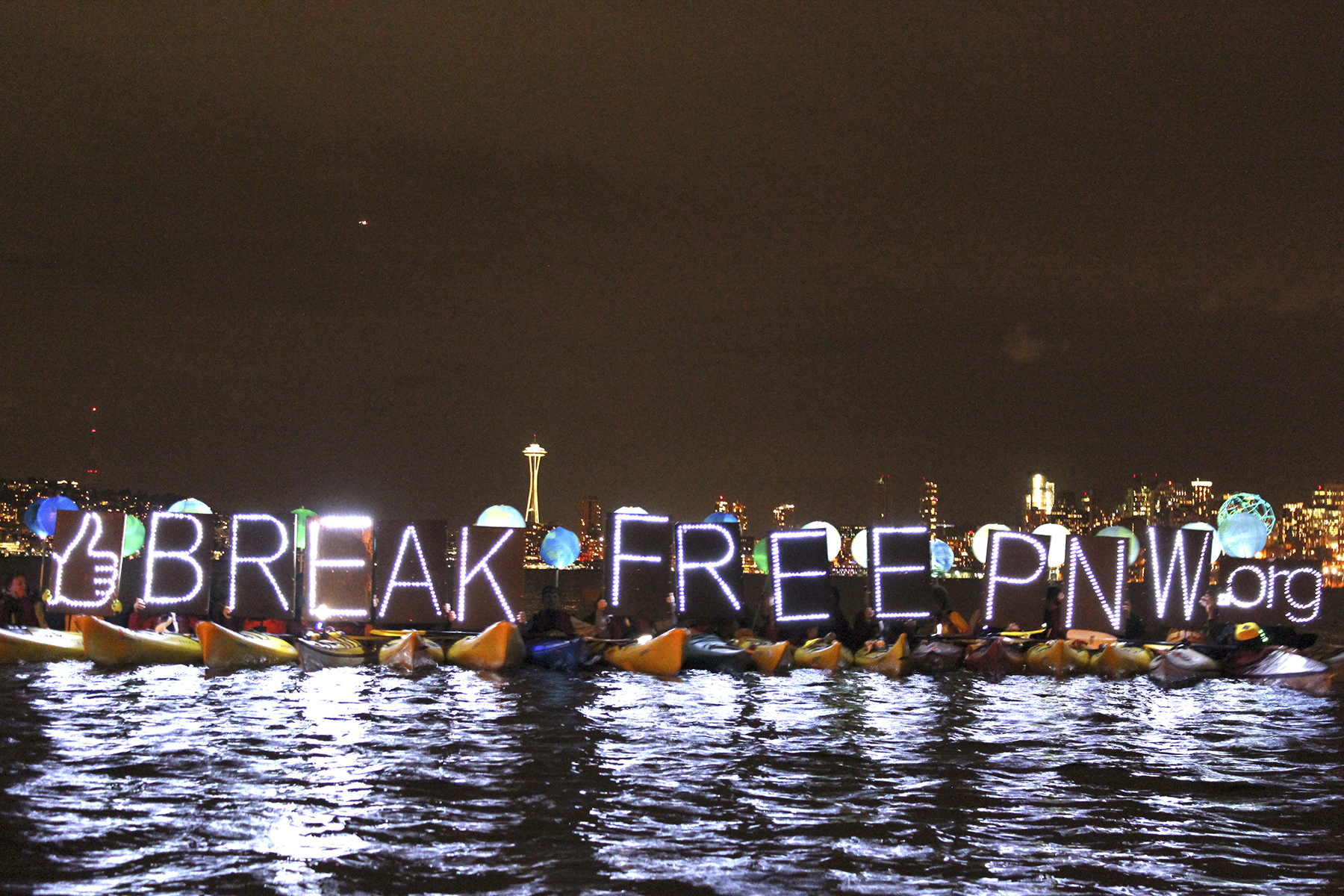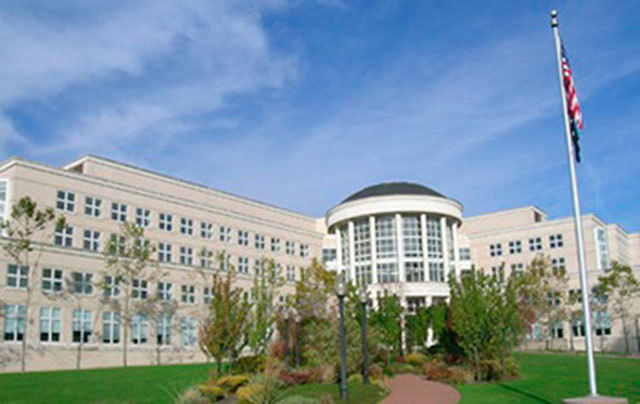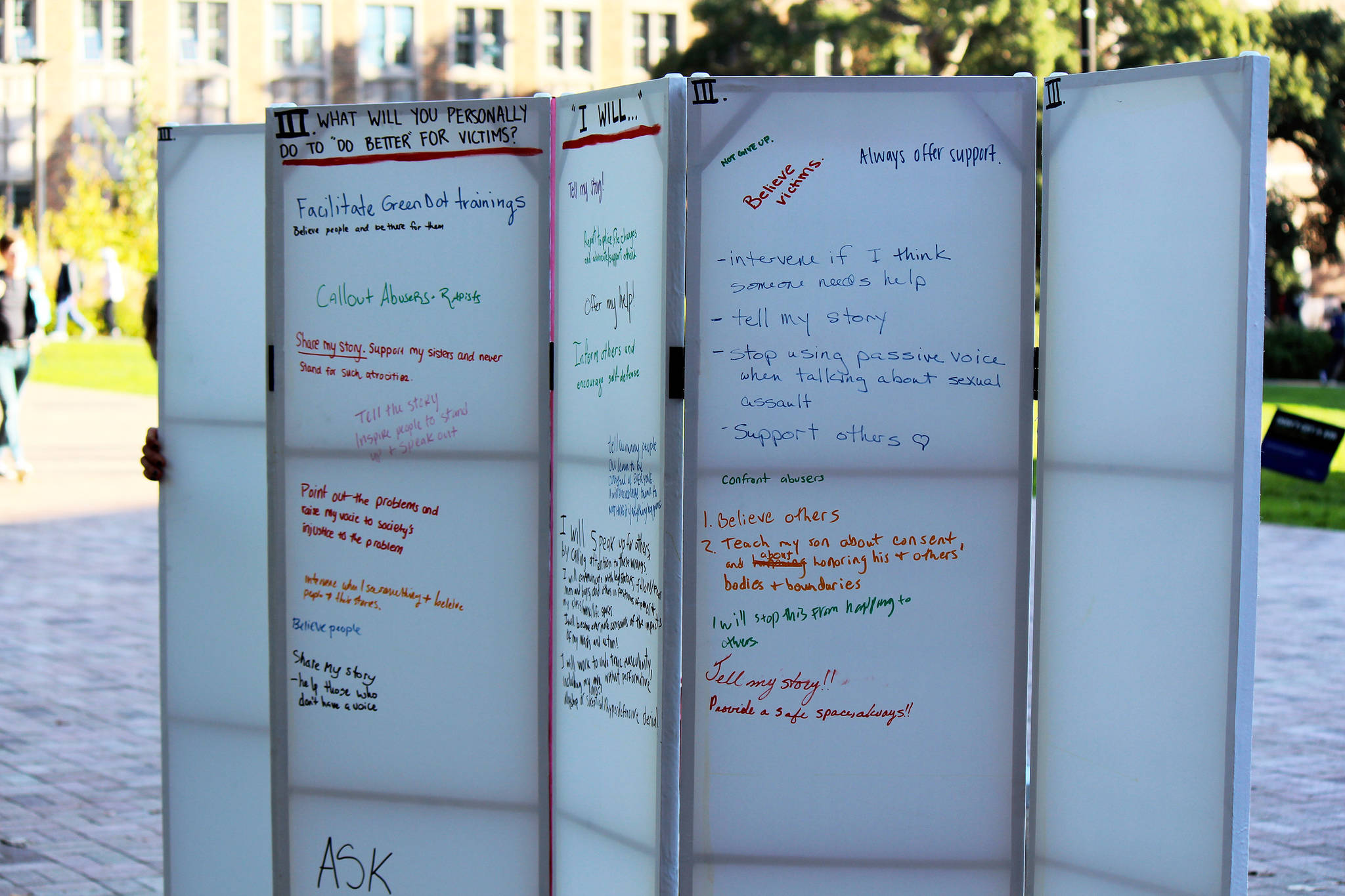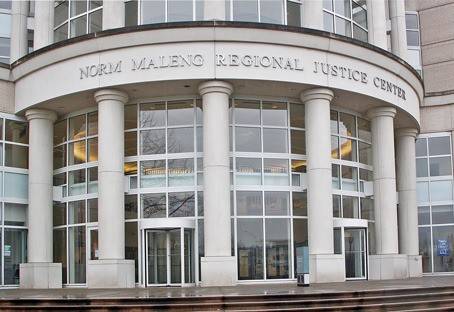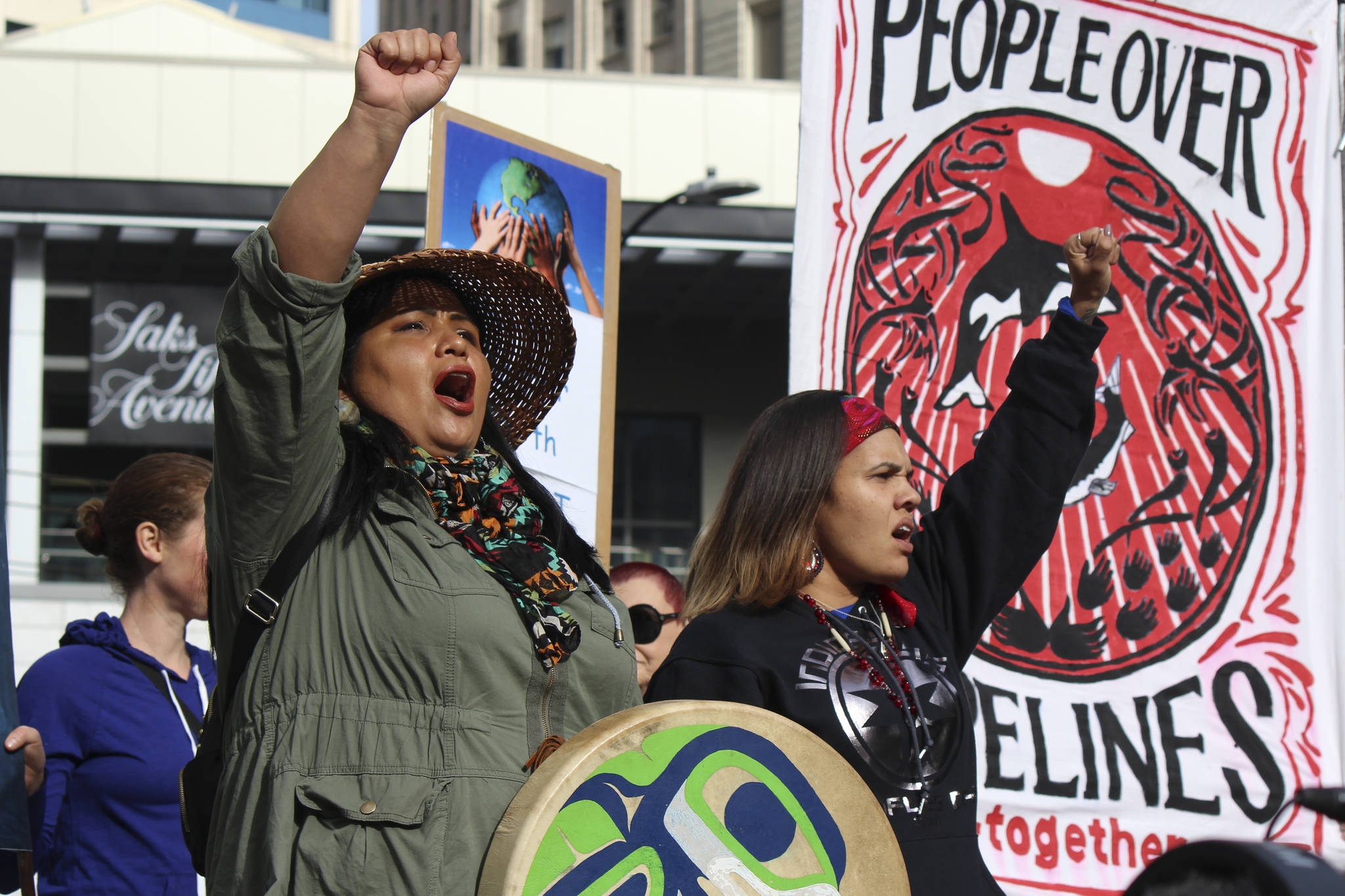As night falls on Earth Day in Seattle, a flotilla of kayaks glides across the chilly water near Alki Beach. Affixed to each stern is an Earth-shaped crepe-paper lantern; the boats bob and glow softly, like a string of fireflies, against the Seattle skyline. Clutched in kayakers’ hands are a dozen LED-lit panels that spell out the url of the next big climate action in the region—one that, organizers hope, will turn last spring’s massive ShellNo protest into a mere dress rehearsal: BREAK FREE PNW.ORG.
Of course, getting everyone to “deploy the imagery” properly isn’t as easy as it sounds.
“Eric Eric Eric, this is Bill Bill Bill… over,” Bill Moyer says into a walkie-talkie as he circles the flotilla in a zodiac. “We need more space between the F and the K… It’s starting to look like BREAKFAST to us… over.”
Moyer—executive director of the Backbone Campaign and arguably the founding father of kayaktivism—is thoroughly enjoying himself. “Isn’t this fun?” he says, grinning. He circles the group, calling out to the kayakers within shouting distance, offering directions, and, when he can recognize them in the dim light, hellos. “Thank you, Margo! Looks awesome! Oh my goodness. Hey Amanda, how are ya? Michael and Sue: Could you back-paddle please?”
He turns back to his passengers. “Not bad work if you can get it, eh? You know, this saved my ass last year. I was so happy to be on the water so much, I am telling you!”
Everyone else here tonight seems happy to have been on the water last year, too, when Shell’s Arctic drilling rig, the Polar Pioneer, was moored at the Port of Seattle and hundreds of kayakers swarmed in protest. The air is thick with nostalgia. “It’s so nice to be out on the water again with you all,” someone says, wistfully.
“We might need to commemorate the Paddle in Seattle,” suggests another, referring to May 16, 2015, when kayaks first circled the rig, making international headlines and sending iconic, David-and-Goliath images across the globe.
“Oh, I feel like we’re doing that,” Moyer replies.
Tonight’s “Luminary Flotilla” is indeed a preparation—both a kayaktivist skills training and a way to drum up support for the upcoming Break Free demonstration in Anacortes, which is expected to be the largest act of climate disobedience the Pacific Northwest has ever seen.
“It’s a massive undertaking, but a beautiful undertaking,” says Moyer, who’s been leading kayaktivist trainings since 2009, when he first corraled what became known as “The Mosquito Fleet” to protest a proposed gravel mine on Vashon-Maury Island—though before ShellNo, no one called them “kayaktivists.” “We have to create friction in the system. It can’t continue going in the way it’s going. The perspective that everything is for sale—from our climate to our democracy to our communities—is bullshit.” Mass civil disobedience helps to “raise people’s expectations for meaningful change,” he says. “The people lead, and the leaders follow.”
At the Paris talks in November, world leaders collectively agreed that we should do everything in our power to keep the global temperature rise from exceeding 1.5 degrees Celsius above pre-industrial levels. As of early April, some models suggest it has already risen by 1.3.
Enter the kayaktivists, stage left.
“We’re not going to get the changes made that need to get made to avoid a climate meltdown,” says activist Patrick Mazza, “unless people raise a really large ruckus.” This weekend, then, the ruckus begins. From Friday through Sunday, thousands of people from across the Pacific Northwest, including Oregon, Washington, Montana, and Idaho, will converge at March Point, the peninsula in Anacortes that houses the Shell and Tesoro oil refineries—the two biggest in Washington state. The event is one of dozens of actions happening under the Break Free banner this month in every corner of the planet, from the Philippines to Nigeria to Brazil to Germany, and it is, to organizers’ knowledge, the largest action happening in the United States. The event’s name speaks to its goal: To break the world of its dependence on fossil fuels.
At least 500 of the nearly 2,000 people who’ve RSVP’d to Break Free in Anacortes have agreed to risk arrest as they “block the flow of oil” in and out of the refineries. The plan, therefore, is to station themselves at the oil-shipping pinch points: “Pipeline, tanker, truck, and train,” says organizer Ahmed Gaya. The kayaks will have their role, too: circling the peninsula from Fidalgo to Padilla Bay, hoisting banners and lights, paddling with tribal canoe familes, and, on Sunday, participating in a mass action “with variable risk level,” according to the Break Free PNW website. Also possible: “a multi-day occupation or blockade.” (Organizers would not discuss more specific details of the actions, concerned that they would tip off law enforcement.)
Likely, if arrested, kayakers and landlubbers would be charged with “criminal trespass,” or other, gentler misdemeanors, such as “public nuisance.” In Washington, there are also laws against obstructing or delaying a train and interrupting or impairing an energy facility’s operations. But any amount of property damage could be construed as “malicious mischief,” and, in the first or second degree, that is a felony charge.
In all, it could turn out to be the biggest act of civil disobedience in Washington since the WTO riots in 1999. And the success of ShellNo, say activists, has everything to do with it. Seattle’s world-famous kayaks grew the movement not only in numbers, but in momentum, says Mazza. He himself was part of a smaller group of activists, the Delta 5, who locked themselves to oil-train tracks in Snohomish County in 2014 to bar access to the Anacortes refineries.
“What we’ve done so far,” Mazza says—all this lawbreaking in the name of climate change, but especially during ShellNo –“makes it possible to contemplate hundreds of people risking arrest.”
The schedule for the weekend is packed on land and sea, including plenty for those who’d rather not find themselves in jail come Sunday evening: workshops, trainings, speeches, music, kayaks, and an “Indigenous Day of Action,” a legal, permitted procession and ceremony along March Point on Saturday led by local tribes. The bulk of attendees will be camping at Deception Pass State Park. And to minimize the fossil fuels needed to transport all those people to the fossil-fuel protest, organizers are arranging transportation through buses, vanpools, carpools, public transit, and several mass bike rides.
March Point has both literal and symbolic significance, organizers argue. It’s the largest point source of carbon pollution in the Northwest; it refines nearly half of all gasoline consumed in the region; and both Shell and Tesoro are trying—right now—to bring additional fossil-fuel infrastructure to Washington: Tesoro wants to build the largest oil-train terminal in the country down in Vancouver, and Shell is seeking permits for a 3-mile rail spur in Anacortes that could open the door to six more mile-long oil trains per week along Washington’s tracks. But activists aren’t demanding that these specific refineries shut down (yet); rather, the smokestacks of March Point represent the industry at large, and “the failure of our local, national, and global governance to address the scale and speed of the climate crisis,” says Gaya.
Riding on the success of ShellNo, organizers are calling for an immediate and “just transition” to renewable energy that takes into account the livelihoods of the millions of people whose economic survival depends on the fossil-fuel industry. Not surprisingly, refinery workers aren’t quite on the same page. “While the USW shares … concerns about the devastating impacts of climate change,” reads a statement from United Steelworkers, which represents employees at the refineries in Anacortes as well as two other Break Free action sites in Pennsylvania and Indiana, “Shutting down a handful of refineries in the U.S. would likely lead to massive job loss in refinery communities, increased imports of refined oil products, and ultimately no impact on reducing global carbon emissions.”
But that kind of hedging and baby-stepping won’t work anymore, says Emily Johnston from the climate-activist group 350 Seattle. “We have to have that conversation now” about replacing fossil-fuel infrastructure worldwide, she argues, not 10 years from now. The consistently ominous climate news, from rapidly melting Arctic ice to the dramatic depletion of ocean oxygen, is “terrifying” in part because “we have no idea how fast [the worst] might happen.” Some big environmental NGOs don’t agree with lawbreaking as a tactic, particularly at a union refinery—part of the reason many of the usual suspects, like the Sierra Club, aren’t partnering on this action—but everyone in this movement “has their spot on the food chain,” Johnston says. “Our position is to be right at the edge of what’s comfortable. Sometimes it’s going to be uncomfortable.”
Break Free PNW is a coalition of at least 40 activist groups and many more individuals, none of whom are getting paid, except through the occasional stipend. (The only person “who’s being paid like a normal human being or something approximating it” for the hours she puts into Break Free, says Johnston, is one staffer from 350 National.) It’s the latest manifestation of a growing—and increasingly people-powered—climate movement in the Northwest. Over the past few years, thousands of people have shown up at oil-train and coal-export and refinery hearings. Tribes have waged years-long battles over treaty and fishing rights. The idea is to form what activists call the Thin Green Line (or the Red Line, depending on whom you ask): a fierce and furious human chain blocking every fossil-fuel project in the Northwest.
Because of these actions, the region has been dubbed by industry insiders as “where energy projects go to die”: Over the past few years, thanks in part to climate activists, the Polar Pioneer was pulled from the Port of Seattle (and Shell pulled out of the Arctic); the company behind what would have been the world’s largest methanol refinery in Tacoma canceled its plans; and of the six coal-export terminals once proposed in Oregon and Washington, just one remains. Just this Monday, the U.S. Army Corps of Engineers denied a permit for the proposed Gateway Pacific Terminal at Cherry Point in Bellingham, citing tribal fishing rights.
“People are revved up, they’re prepared, they get it, and more and more people join in with each fight,” says Johnston. “Given that this is up in Anacortes”—far from Seattle and “not an easy place to house people or feed people or any of those things,” you’d think attendance would be sparse. However, Break Free is lining up to be significantly bigger than ShellNo, which never topped 1,000.
“Pretty amazing,” she says.
As activists prepare for the massive demonstration, what’s becoming clearer and clearer is that ShellNo marked a major turning point in climate action, both here and across the globe. It’s the reason 350 Seattle’s e-mail lists have swelled; the reason organizers are pulling off Break Free PNW with a fraction of the funding and paid staff available during ShellNo (Rising Tide Seattle’s Ahmed Gaya estimates that between salaries and money to pay for all the logistics, ShellNo cost its organizers at least $500,000); the reason that the city of Seattle has a kayak-shaped stamp on the global map.
“There are now people doing kayaktivist actions on the Seine, on the Danube,” says Johnston. (And in Portland. And San Francisco. And Chicago.) “It was like, ‘Oh, this really hit a nerve!’ That was not something we expected at all.”
Gaya, a 30-year-old activist who’s been involved in the climate movement for nearly a decade, points to a term that famed organizer Saul Alinsky coined during the Civil Rights era: “a moment of the whirlwind.” It was his way of describing the tipping point for social change when things begin to happen of their own accord and it’s organizers’ turn to step back and watch—when the “normal rules no longer apply, when everything is happening faster and more intensely,” Gaya says, and the scene transforms from activists leading a campaign to people leading a movement.
“ShellNo definitely felt like that,” he says. “For me, ShellNo was one of the most profound moments that I’ve experienced in organizing.”
It wasn’t that ShellNo caused more people to care about climate change than already did. It was, rather, a crystallization. It gave people something to latch on to. Shell’s rig “was a physical embodiment of an existential problem,” Gaya says. “I think a lot of people feel a lot of emotion around the climate crisis, and it’s this, like, ethereal thing. It’s hard to be like, you feel stressed about the climate crisis, you’re angry and upset and scared, so… ‘Call your legislator’? That doesn’t feel concrete and tangible.” The oil rig “was a very powerful foil for people.”
Alice Lockhart is among the many Seattleites who joined the climate-activist ranks during and after ShellNo. She says she always cared about climate change, but had no idea what to do and was trying not to think about it. “It’s really hard sometimes to do anything,” she says. “You feel paralyzed.” It wasn’t until last spring, after she’d finished Naomi Klein’s This Changes Everything and felt both horribly depressed and morally galvanized (“I cried all the way through”) that she noticed the kayaks on the water and felt compelled to act. She marched into her boss’ office at Microsoft and announced that she was going to ShellNo and that she could be arrested (“That didn’t go over too well”); a few months later, in August, she quit her job to become a full-time organizer.
At first that meant joining protests at the BNSF offices and at hearings for Tacoma’s proposed methanol refinery; now it means working on transportation logistics for Break Free PNW. It’s a tremendous, unpaid task, she says, and “a lot like, you know, work. The difference [between it and Microsoft] is we sing more songs and hug each other a lot more.”
And that’s really the heart of it, for Lockhart and many of the people who’re picking up kayak paddles, LED panels, and banners and locking themselves to train tracks, climbing fences, hanging from bridges, and circling oil rigs: feeling at last like they’re “not alone in this sheer terror” about what will happen to the world if we don’t change things. “The fighting together,” she says, “is so much better.”
Fighting, and—a little more often now—winning. Not with “superior force, or with more money,” argues Patrick Mazza, but “with the moral force of people power. People standing up and putting themselves in the way, putting their bodies on the line. That’s what this is all about. You’ve got all these distractions in our world. And this is kind of what it takes.” ■
